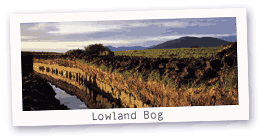 |
Search the site:

 Irish Landscape | Lowland BogThe topography of central Ireland is such that when the icesheets disappeared the entire middle reaches of the Shannon were a great shallow lake, many times the area of Lough Neagh. Its lime-rich surrounds supported a rush-and-sedge vegetation which formed fen peats encroaching into the water. When this reached a foot or two thickness it sealed off the soil nutriments below and the swamp vegetation abruptly changed in character. Bog mosses in particular began to flourish, as did plants suited to the increasingly acid conditions. The moss has the ability to swell with water like a sponge, and so the bog surface became gently arched above the surrounding lands. supported a rush-and-sedge vegetation which formed fen peats encroaching into the water. When this reached a foot or two thickness it sealed off the soil nutriments below and the swamp vegetation abruptly changed in character. Bog mosses in particular began to flourish, as did plants suited to the increasingly acid conditions. The moss has the ability to swell with water like a sponge, and so the bog surface became gently arched above the surrounding lands.This is the raised bog of the Irish lowlands, its surface diversified by hummocks of bog moss with pools trapped among them. Bog cotton, deer grass and insectivorous plants - sundew and butterwort - characterise the harsh environment. Where it has dried out, heathers, namely ling and erica, cover the firmer ground. This dried-out bog near Roosky, with turf-cutting in the old-fashioned, manual way, shows a layered character arising from the fact that peat formation (humification or breakdown of vegetable remains) is a function of climate. Warm, dry conditions make for structureless, homogeneous peat; cool, wet climates favour preservation of raw plant debris. Airborne pollen falling on the surface is minutely preserved in peat as the bog builds up in time. Individual grains, especially tree pollen, are clearly identifiable, and their changing abundances successive levels enable the forest composition and its variation to be followed over the 9,000 years since peat formation began. Pine forest, a taiga vegetation, predominated at first but gave way to deciduous woodland as climate improved. Pine came extinct by 1,500 BC, and the conifers now growing are reintroductions.
|
[ Back to Top ]
All Material © 1999-2004 Irelandseye.com and contributors
